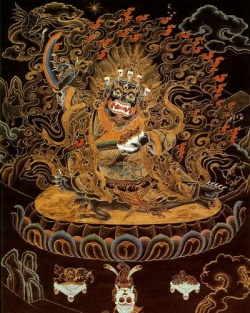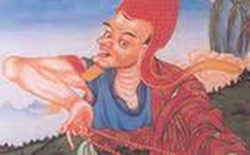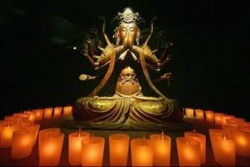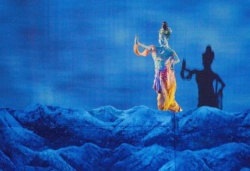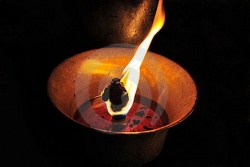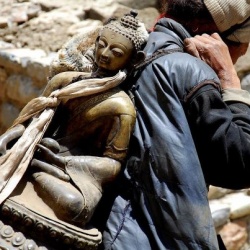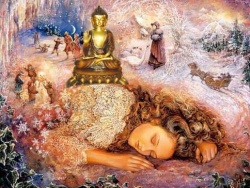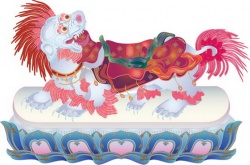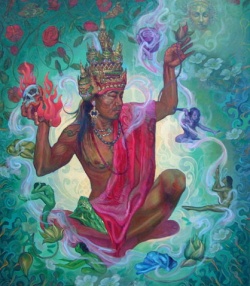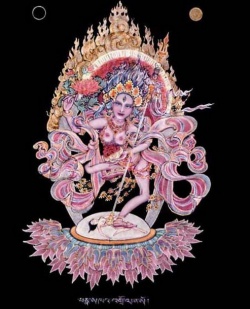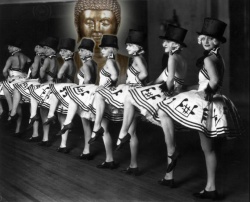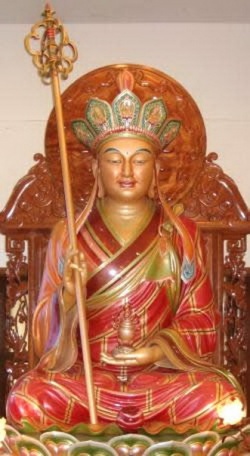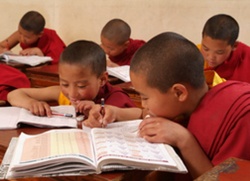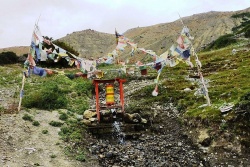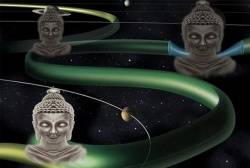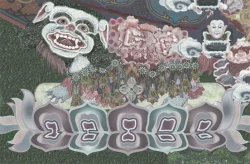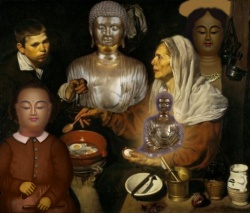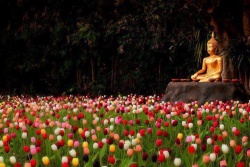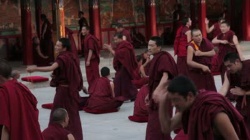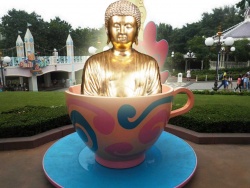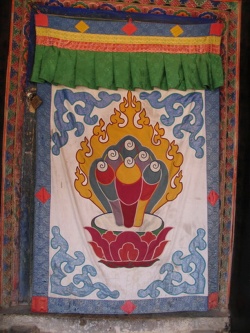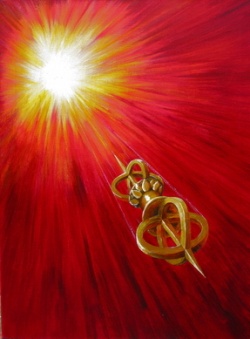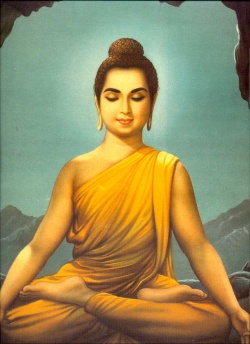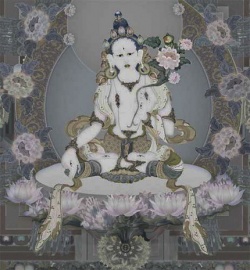Puggala Paññatti
Puggala-paññatti; ("Designation of Persons")--classifies types of individuals according to their spiritual traits and stages'.
Bodhipakkhiya Dipani
The Manual of The Factors Leading to Enlightenment, Introduction
by Mahathera Ledi Sayadaw, Aggamahapandita, D.Litt.
Translated into English by Sayadaw U Nyana, Patamagyaw of Masoeyein Monastery Mandalay.
Edited by The English Editorial Board
Note to the electronic version:
This electronic version is reproduced directly from the printed version The text is an English translation from the original Burmese. No attempt has been made to to change any of the English phraseology. The reason for putting this book into electronic media is that the book is out of print and the text has been found very a valuable source of inspiration to those practising Vipassana meditation, despite using English language which is somewhat archaic.
Translator's Preface
The Venerable Ledi Sayadaw's works are well known in Burma. They are widely known because they are clear expositions of the Buddha-Dhamma couched in language easily intelligible to an ordinary educated Burman. Yet the Venerable Sayadaw's works are not meant for an absolute beginner in Buddhist studies. There are many technical Buddhist words which require a certain amount of previous foundation in Buddhist tradition and practice.
The Venerable Sayadaw's exposition contains many technical Pali words which are used by him as if they were ordinary Burmese words. Many of these words have been incorporated into the Burmese language either in their original Pali form of with slight variations to accord with Burmese euphony. These are words which Burmans have made no attempt to translate, but have preferred to absorb them into the normal usage of the Burmese language. I have, similarly, made no attempt to translate many of them into English in the present translation. I have used these words in their original Pali form though in all such cases an attempt has been made to append short explanatory footnotes in order to facilitate continuity in reading.
Though the translation is not verbatim, yet a careful attempt has been made to render as nearly a verbatim translation as is possible in the circumstances, having regard to differences in the construction of sentences between English and Burmese, to differences in the manner of presentation, and to the Venerable Sayadaw's penchant for sometimes using extremely long sentences.
Many of the sub-headings and sub-titles are not in the original text, but have been introduced by the translator in order to assist the English reader.
The Venerable Sayadaw was a prolific writer. His works number over a hundred. Each of these works was written at the specific request of one or more of his innumerable disciples, either as an answer to certain questions put to him, or as in the present case, to expound certain important points or aspects of the Buddha-Dhamma. Sein Nyo Tun. 135, University Avenue, Rangoon.
Introduction
In compliance with the request of the Pyinmana Myo-ok Maung Po Mya and Trader Maung Hla, during the month of Nayon, 1266 Burmese Era (June 1904 C.E.), I shall state concisely the meaning and intent of the thirty-seven (factors leading to enlightenment) bodhipakkhiya-dhamma.
Four Classes of Individuals
It is stated in the Puggala Pannatti[1] (the book of Classification of Individuals) and the Anguttara-Nikaya[2] that, of the beings who encounter the Sasanas (teachings) of the Buddhas, four classes can be distinguished:
Ugghatitannu
Vipancitannu
Neyya and
Padaparama.
Of these four classes of beings, an ugghatitannu is an individual who encounters a Buddha in person, and who is capable of attaining the holy Path and the holy Fruits through the mere hearing of a short concise discourse.
A vipancitannu is an individual who has not the capability of attaining the Paths and the Fruits through the mere hearing of a short discourse, but who yet is capable of attaining the Paths and the Fruits when the short discoure is expounded to him at some length.
A neyya is an individual who has not the capability of attaining the Paths and the Fruits through the hearing of a short discourse, or when it is expounded to him at some length, but is one for whom it is necessary to study and take careful note of the sermon and the exposition, and then to practise the provisions contained therein for days, months, and years, in order that he may attain the Paths and the Fruits.
This neyya class of individuals can again be sub-divided into many other classes according to the period of practice which each individual finds necessary before he can attain the Paths and the Fruits, and which further is dependent on the parami (perfections) which each of them has previously acquired, and the kilesa (defilements) which each has surmounted. These classes of individuals include, on the one hand, those for whom the necessary period of practice is seven days, and on the other, those for whom the necessary period of practice may extend to thirty or sixty years.
Further classes also arise, as for example, in the case of individuals whose necessary peroid of practice is seven days, the stage of an arahat may be attained if effort is made in the first or second period of life,[3] which no more than the lower stages of the Paths and the Fruits can be attained if effort be made only in the third period of life.
Then, again, putting forth effort for seven days means exerting as much as is in one's power to do so. If the effort is not of the highest order, the peroid of necessary effort becomes lengthened according to the laxity of the effort, and seven days may become seven years or longer. If the effort during this life is not sufficiently intense as to enable one to attain the Paths and the Fruits, then release from worldly ills cannot be obtained during the present Buddha Sasana, while release during future Buddha Sasanas can be obtained only if the individual encounters them. No release can be obtained if no Buddha Sasana is encountered.
It is only in the case of individuals who have secured niyata vyakarana (sure prediction made by a Buddha), is an encounter with a Buddha Sasana and release from worldly ills certain. An individual who has not attained niyata vyakarana cannot be certain either of encountering a Buddha Sasana or achieving release from worldly ills, even though he has accumulated sufficient parami to make both these achievements possible.
These are considerations in respect of those individuals who possess the capabilities of attaining the Paths and the Fruits by putting forth effort for seven days, but who have not obtained niyata vyakarana.
Similar considerations apply to the cases of those individuals who have the potentiality of attaining the Paths and the Fruits by putting forth effort for fifteen days, or for longer periods.
A padaparama is an individual who, though he encounters a Buddha Sasana, and though he puts forth the utmost possible effort in both the study and practice of the Dhamma, cannot attain the Paths and the Fruits within this lifetime. All that he can do is to accumulate habits and potentials.[4]
Such a person cannot obtain release from worldly ills during this life-time. If he dies while practising samatha (calm) or vipassana (insight) and attains rebirth either as a human being or a deva in his next existence, he can attain release from worldly ills in that existence within the present Buddha Sasana.
Thus did the Buddha say with respect to four classes of individuals.
Three Types of Individuals
In the same Pitakas referred to above, the Buddha gave another classification of beings, dividing them into three classes according as they resembled three kinds of sick persons. The three kinds of sick persons are:
A person who is certain of regaining health in due time even though he does not take any medicine or treatment.
A person who is certain of failing to make a recovery, and dying from the illness, no matter to what extent he may take medicines or treatment.
A person who will recover if he takes the right medicine and treatment, but who will fail to recover and die if he fails to take the right medicine and treatment.
These are the three kinds of sick persons.
Persons who obtained niyata vyakarana (sure prediction made by a Buddha) from previous Buddhas, and who as such are certain of obtaining release from worldly ills in this life, resemble the first class of sick persons.
An individual of the padaparama class resembles the second class of sick person. Just as this second class of sick person has no chance of recovery from his illness, an individual of the padaparama class has no chance of obtaining release from worldly ills during this life. In future lives, however, he can obtain release either within the present Buddha Sasana, or within future Buddha Sasanas. The story of the youth Chattamanava,[5] of the frog who became a deva,[6] and of the ascetic Saccaka,[7] are illustrations of persons who obtained release from worldly ills in their next following existences within the present Buddha Sasana.
An individual of the neyya class resembles the third class of sick person. just as a person of this third class is related to the two ways of either recovering or dying from the sickness, so is a neyya individual related to the two eventualities of either obtaining release from worldly ills during the present life, or failing to obtain such release.
If such a neyya individual, knowing what is good for him according to his age, discards what should be discarded, searches for the right teacher, and obtains the right guidance from him and puts forth sufficient effort, he can obtain release from worldly ills in this very life. If, however, he becomes addicted to wrong views and wrong ways of conduct, if he finds himself unable to discard sensual pleasures, if although able to discard sensual pleasures he does not obtain the guidance of a good teacher, if although obtaining the guidance of a good teacher, he is unable to evoke sufficient effort, if although inclined to put forth effort he is unable to do so through old age, if although young he is liable to sickness, he cannot obtain release from worldly ills in this present life. King Ajatasattu,[8] the millionaire Mahadhana's son,[9] Bhikkhu Sudinna,[10] are cases of persons who could have obtained release from worldly ills in this present existence.
King Ajatasattu failed to obtain release because he had committed patricide. It is stated that he will drift in future samsara (round of rebirths) for two asankheyyas (unit followed by 140 ciphers) world-cycles, after which he will become a paccekabuddha (solitary Buddha).
The millionaire Mahadhana's son indulged himself so excessively in sensual pleasures during his youth that he was unable to attain tranquillity of mind when he grew older. Far from obtaining release from worldly ills, he did not even get the opportunity of associating with the Ti-Ratanas.[11] Seeing his plight at that stage, the Buddha said to Ananda: "Ananda, if this millionaire's son had become a bhikkhu in my sasana during his youth or first period of his life, he would have become an arahat and would have attained parinibbana[12] in this present life. If, otherwise, he had become a bhikkhu during the second period of his life, he would have become an anagami,[13] and on death would have been reborn in the suddhavasa brahma loka,[14] whence he would have attained parinibbana, In the next alternative, if he had become a bhikkhu in my sasana at the beginning of the third period of life, he would have become either a sakadagami[15] or a sotapanna,[16] and would have attained permanent release from rebirth in the apaya loka."[17] Thus said the Buddha to the Venerable Ananda. Thus, although, he (the millionaire Mahadhana's son) possessed parami ripe enough to make his present existence his last existence, not being a person who) had secured niyata vyakarana, he failed to obtain release from worldly ills in this present life because of the upheavals caused by the defilements within him, and this is despite the fact that he had the opportunity of encountering the Buddha Sasana. If further, his period of existence in the apaya loka is prolonged because of evil acts done in this existence, he would not be able to rise again and emerge out of those apaya lokas in time for the sasana of the future Metteyya Buddha. And, after that, the large number of world-cycles that follow are world-cycles where no Buddhas appear,[18] there being no world-cycles within the vicinity of the present world where Buddhas are due to appear. Alas! far indeed is this millionaire's son from worldly ills even though he possessed parami ripe enough to make his present existence his last existence.
The general opinion current at the present is that, if the parami are complete, one cannot miss encountering a Buddha Sasana even if one does not wish to do so, and that one's release from worldly ills is ensured even though one may not desire such release. These people fail to pay attention to the existence of niyata (one who has obtained a sure prediction made by a Buddha) and aniyata (one who has not obtained a sure prediction made by a Buddha). Considering the two texts from the Pitaka mentioned above, and the story of the millionaire Mahadhana's son, it should be remembered that aniyata neyya individuals can attain release from worldly ills in this life only if they put forth sufficient effort, even if they possess parami sufficient to enable them to obtain such release. If industry and effort are lacking, the Paths and the Fruits cannot be attained within the present Buddha Sasana.
Apart from these classes of persons, there are also an infinite number of other beings who, like the ascetics Alara and Uddaka,[19] possess sufficient parami for release from worldly ills, but who do not get the opportunity, because they happen to be in one or the other of the eight inopportune places (atthakkhanas)[20] where it is not possible to attain the Paths and the Fruits thereof.
(Here ends the part showing the division of beings into four and three classes according to Puggala Pannatti of the Abhidhamma Pitaka and the Anguttara-Nikaya of the Suttanta Pitaka).
Necessary Conditions of Practice for Neyya and Padaparama
Of the four classes of individuals mentioned, the Ugghatitannu and the vipancitannu classes can attain the sotapatti-magga (path of a stream-winner) and the other higher stages of wisdom--like Visakha and Anathapindika[21]--through the mere hearing of a discourse. It is not necessary for such individals to practise the Dhamma according to the stages of practice such as sila-visuddhi (purification of virtue), citta-visuddhi (purification of consciousness) and so on. Be it remembered that this is also the case when devas and Brahmas attain release from worldly ills.
Hence, it should be noted that the courses of practice, such as sila-visuddhi and citta-visuddhi, laid down in the Pali Canon, are only for the neyya and padaparama classes of individuals before their attainment of the sotapatti-magga. These courses of practice are also for the first three classes of individuals prior to the achievement of the higher stages of the Paths and the Fruits. In the period after the attainment of arahatship also, these courses of practice are used for the purpose of dittha-dhamma-sukhavihara [22] (dwelling at ease in this present existence), since arahats have already gone through them.
After the passing of the first thousand years (of the present Buddha Sasana), which constituted the times of the patisambhidha-patta arahat (arahat possessing analytical knowledge), the period of the present Buddha Sasana comprises the times of the neyya and padaparama classes of individuals alone. At the present day, only these two classes of individuals remain.
Of These Two Classes of Individuals
Neyya-Puggala:
Of these two classes of individuals, an individual of the neyya class can become a sotapanna in this present life if he faithfully practises the bodhipakkhiya-dhamma comprising satipatthana (four applications of mindfulness), sammapadhana (right exertion), else. If he is lax in his practice, he can become a sotapanna only in his next existence after being reborn in the deva planes. If he dies while still aloof from these (bodhipakkhiya) dhamma, such as satipatthana, etc., he will become a total loss so far as the present Buddha Sasana is concerned, but he can still attain release from worldly ills if he encounters the Sasana of the next Buddha.
Padaparama-Puggala Extant:
An individual of the padaparama class can attain release within the present Buddha Sasana after rebirth in the deva planes in his next existence, if he can faithfully practise these(bodhipakkhiya) dhamma in his present existence.
The Age of Ariyas (Noble Ones) still:
The five thousand years of the present Buddha Sasana constitute, all of them, the age of ariyas. This age of ariyas will continue to exist so long as the Tipitaka remain in the world. The padaparama class of individuals have to utilise the opportunity afforded by the encountering of the present Buddha Sasana to accumulate as much of the nuclei or seeds of parami as they can within this lifetime. They have to accumulate the seeds of sila (morality). They have to accumulate the seeds of samadhi (concentration). They have to accumulate the seeds of panna (wisdom).
Sila:
Of these three kinds of accumulations, sila (morality), samadhi (concentration), panna (wisdom), the seeds of sila mean: panca-sila,[23] Ajivatthamaka-sila,[24] atthanga-uposatha-sila,[25] dasanga sila,[26] in respect of ordinary laymen and women, and the bhikkhu-sila [27] in respect of the bhikkhus.
Samadhi:
The seeds of samadhi means the effort to achieve parikamma-samadhi (preparatory concentration) through one or other of the forty objects of meditation, such as the ten kasina (meditation devices), or, if further effort can be evoked, the effort to achieve upacara-samadhi (access concentration), or, if still further effort can be evoked, the effort to achieve appana-samadhi (attainment concentration.)
Panna:
The seeds of panna means the cultivation of the ability to analyse the characteristics and qualities of rupa (material phenomena), nama (mental phenomena), khandha (constituent groups of existence), ayatana (bases), dhatu (elements), sacca (truths), and the paticcasamuppada (dependent origination), and the cultivation of insight into the three characteristics of existence (lakkhana), namely, anicca (impermanence), dukkha (suffering), anatta (impersonality).
Of the three kinds of seeds of magga-nana and phala-nana,[28] sila and samadhi are like ornaments that permanently adorn the world, and exist even in the sunna world-cycles that is, world-cycles where no Buddhas arise. The seeds of sila and samadhi can be obtained at will at any time. But the seeds of panna, which are related to rupa, nama, khandha, ayatana, dhatu, sacca, and paticcasamuppada, can be obtained only when one encounters a Buddha Sasana. Outside of a Buddha Sasana, one does not get the opportunity of even hearing the mere mention of words associated with panna, though an infinite number of 'sunna' world-cycles may elapse. Hence, those persons of the present day who are fortunate enough to be born into this world while a Buddha Sasana flourishes, if they intend to accumulate the seeds of magga-nana for the purpose of securing release from worldly ills in a future existence within a future Buddha Sasana, should pay special attention to the knowledge of the paramattha[29] (ultimate realities), which is extremely difficult for one to come across, more than they attempt the accumulation of the seeds of sila and samadhi. In the least, they should attempt to obtain an insight into how the four great primaries (mahabhuta)--pathavi, apo, tejo and vayo are constituted in one's body. If they acquisition a good insight into the four great elements, they obtain a sound collection of the seeds of panna which are most difficult of acquisition, and this is so even though they may not acquire any knowledge of the other portions of the Abhidhamma. It can then be said that the difficult attainment of rebirth within a Buddha Sasana has been made worthwhile.
Vijja (Knowledge) And Carana (Conduct):
Sila and samadhi constitute carana, while panna constitutes vijja. Thus are vijja-carana (knowledge and conduct) constituted. Vijja resembles the eyes of a human being, while carana resembles the limbs. Vijja is like eyes in birds, while carana is like wings. A person who is endowed with morality and concentration, but lacks wisdom, is like one who possesses complete and whole limbs but blind of both eyes. A person who is endowed with vijja (knowledge), but lacks carana (conduct), is like one who has good eyesight but is defective in his limbs, A person who is endowed with both vijja and carana is like a normally whole person possessing both good eyesight and healthy limbs. A person who lacks both vijja and carana is like one defective in eyes and limbs, and is not one worthy of being called a living being.
Consequences of Having Carana Only:
Amongst the persons living within the present Buddha Sasana, there are some who are fully endowed with morality and concentration, but do not possess the seeds of vijja (knowledge), such as insight into the nature of material qualities, mental qualities and constituent groups of existence. Because they are strong in carana, they are likely to encounter the next Buddha Sasana, but because they lack the seeds of vijja, they cannot attain enlightenment, even though they hear the discourse of the next Buddha in person. They are like Laludayi Thera,[30] Upananda Thera,[31] Chabbaggiya Bhikkhus,[32] and the King of Kosala,[33] during the lifetime of the Omniscient Buddha. Because they were endowed with the previously accumulated carana, such as alms-giving and morality, they had the opportunity to associate with the Supreme Buddha, but since they lacked previously accumulated vijja, the discourses of the Buddha which they often heard throughout their lives, as it were, fell on deaf ears.
Of Having Vijja Only:
There are others who are endowed with vijja, such as insight into the material and mental qualities and the constituent groups of existence, but who lack carana, such as dana, nicca-sila (permanent morality) and uposatha-sila (precepts observed on fasting days). Should these persons get the opportunity of meeting and hearing the discourses of the next Buddha, they can attain enlightenment because they possess vijja, but since they lack carana, it would be extremely difficult for them to get the opportunity of meeting the next Buddha. This is so because there is an antara-kappa (intervening world-cycle) between the present Buddha Sasana and the next.
In case these beings wander within the sensuous sphere during this period, it means a succession of an infinite number of existences and rebirths, and an opportunity to meet the next Buddha can be secured only if all these rebirths are confined to the happy course of existence. If, in the interim, a rebirth occurs in one of the four lower regions, the opportunity to meet the next Buddha would be irretrievably lost, for one rebirth in one of the four lower worlds is often followed by an infinite number of rebirths in one or other of them.
Those persons whose acts of dana (alms-giving) in this life are few, who are ill-guarded in their bodily acts, unrestrained in their speech, and unclean in their thoughts, and who thus are deficient in carana (conduct), possess a strong tendency to be reborn in the four lower worlds when they die. If through some good fortune they manage to be reborn in the happy course of existence, wherever they may be reborn, they are, because of their previous lack of carana, such as dana, likely to be deficient in riches, and likely to meet with hardships, trials, and tribulations in their means of livelihood, and thus encounter tendencies to rebirth in the apaya loka. Because of their lack of carana of nicca-sila and uposatha-sila, they are likely to meet with disputes, quarrels, anger and hatred in their dealings with other persons, in addition to being susceptible to diseases and ailments, and thus encounter tendencies towards rebirth in the apaya lokas. Thus will they encounter painful experiences in every existence, gathering undesirable tendencies, leading to the curtailment of their period of existence in the happy course of existence and causing rebirth in the four lower worlds. In this way, the chances of those who lack carana meeting the next Buddha are very few indeed.
The Essential Point:
In short, the essential fact is, only when one is endowed with the seeds of both vijja and carana can one obtain release from worldly ills in one's next existence. If one possesses the seeds of vijja alone, and lacks the seeds of carana, such as dana and sila, one will fail to secure the opportunity of meeting the next Buddha Sasana. If, on the other hand, one possesses the seeds of carana but lacks the seeds of vijja, one cannot attain release from worldly ills even though one encounters the next Buddha Sasana. Hence, those padaparama individuals of today, be they men or women, who look forward to meeting the next Buddha Sasana, should attempt to accumulate within the present Buddha Sasana the seeds of carana by the practice of dana, sila and samatha- bhavana (practice of calm), and should also, in the least, with respect to vijja try to practise insight into the four great primaries, and thus ensure meeting the next Buddha Sasana, and having met it, to attain release from worldly ills.
When it is said that dana is carana, it comes under the category of saddha (faith), which is one of the saddhamma or practical conduct of good people, which again comes under the fifteen carana-dhamma. The fifteen carana-dhamma are:
sila (morality)
indriya-sarhvara (guarding the sensedoors)
bhojanemattannuta (moderation in eating)
jagariyanuyoga (wakefulness)
5-11 saddhamma (the seven attributes of good and virtuous men)
12-15 four jhana-first jhana, second jhana, third jhana, and fourth jhana.
These fifteen dhamma are the property of the highest jhanalabhi (attainer of jhana). So far as sukkhavipassaka (practising insight only) individuals are concerned, they should possess the eleven carana dhamma, i.e. without the four jhana.
For those persons who look forward to meeting the next Buddha Sasana, dana, sila uposatha, and the seven saddhamma are the essentials.
Those persons who wish to attain the Paths and the Fruits thereof in this very life must fulfil the first eleven carana-dhamma, i.e. sila, indriya-samvara, bhojanemattannuta, jagariyanuyoga, and the seven saddhamma. Herein, sila means ajivatthamaka-nicca-sila (permanent practice of morality ending with right livelihood); indriya-samvara means guarding the six sense-doors--eyes, ears, nose, tongue, body and mind; bhojanemattanuta means taking just sufficient food to preserve the balance of the corporeality group in the body and being satisfied therewith; jagariyanuyogo means not sleeping during the day, and sleeping only during one period (of the three periods) of the night, practising bhavana (mental concentration) during the other two periods.
Saddhamma means:
saddha (faith)
sati (mindfulness)
hiri (moral shame)
ottappa (moral dread)
bahusacca (great learning)
viriya (energy; diligence)
panna (wisdom).
For those who wish to become sotapannas during this life, there is no special necessity to practise dana (alms-giving). But let those who find it unable to evoke sufficient effort towards acquiring the ability to obtain release from worldly ills during the present Buddha Sasana make special attempts to practise dana (alms-giving) and uposatha (precepts observed on fasting days).
Order of Practice And Those Who Await the Next Buddha
Since the work in the case of those who depend on and await the next Buddha consists of no more than acquiring accumulation of parami, it is not strictly necessary for them to adhere to the order of the stages of practice laid down in the Pali Texts: sila, samadhi and panna. They should not thus defer the practice of samadhi before the completion of the practice of sila, or defer the practice of panna before the completion of the practice of samadhi. In accordance with the order of the seven visuddhi (purifications), such as sila-visuddhi (purification of virtue), citta-visuddhi (purification of consciousness), ditthi-visuddhi (purification of view), kankhavitarana-visuddhi (purification by overcoming doubt), maggamaggananadassana-visuddhi (purification by knowledge and vision of what is and what is not path), patipadananadassana-visuddhi (purification by knowledge and vision of the way), and nanadassana-visuddhi (purification by knowledge and vision), they should not postpone the practice of any course for a visuddhi until the completion of the respective previous course. Since they are persons engaged in the accumulation of as much of the seeds of parami as they can, they should contrive to accumulate the largest amount of sila, samadhi, and panna that lies in their power.
Unnecessary to Adhere to the Prescribed Order of Practice
When it is stated in the Pali Texts that citta-visuddhi should be practised only after the completion of the practice of sila-visuddhi, that ditthi-visuddhi should be practised only after the completion of the practice of citta-visuddhi, that kankhavitarana-visuddhi should be practised only after the completion of the practice of ditthi-visuddhi, that the work of anicca, dukkha, and anatta-bhavana (contemplation of impermanence, suffering and impersonality) should be undertaken only after the completion of the practice of kankhavitarana-visuddhi, the order of practice prescribed is meant for those who attempt the speedy realisation of the Paths and the Fruits thereof in this very life. Since those who find it unable to call forth such effort, and are engaged only in the accumulation of the seeds of parami are persons occupied in grasping whatever they can, it should not be said in their case that the work of samatha manasikara citta-visuddhi (the practice of purification of consciousness consisting of advertence of mind to tranquillity) should not be undertaken before the fulfilment of sila-visuddhi. Even in the case of hunters and fishermen, it should not be said that they should not practise samatha vipassana (calm and insight) manasikara (advertence of mind towards calm and insight) unless they discard their avocations. One who says so causes dhammantaraya (danger to the dhamma). Hunters and fishermen should, on the other hand, be encouraged to contemplate the noble qualities of the Buddha, the Dhamma, and the Sangha. They should be induced to contemplate, as is in their power, the characteristic of loathsomeness in one's body. They should be urged to contemplate the liability of oneself and all creatures to death. I have come across the case of a leading fisherman who, as a result of such encouragement, could repeat fluently from memory the Pali Text and'nissaya' (word for word translation) of the Abhidhammatha Sangaha, and the Paccaya Niddesa of the Patthana (Book of Relations), while still following the profession of a fisherman. These accomplishments constitute very good foundations for the acquisition of vijja (knowledge).
At the present time, whenever I meet my dayaka upasakas (lay disciples who contribute to a bhikkhu's upkeep), I tell them, in the true tradition of a bhikkhu, that even though they are hunters and fishermen by profession, they should be ever mindful of the noble qualities of the Three Jewels and three characteristics of existence. To be mindful of the noble qualities of the ti-ratana (Triple Gem) constitutes the seed of carana. To be mindful of the three characteristics of existence constitutes the seed of vijja. Even hunters and fishermen should be encouraged to practise the advertence of mind. They should not be told that it is improper for hunters and fishermen to practise advertence of mind towards samatha (calm) and vipassana (insight). On the other hand, they should be helped towards better understanding, should they be in difficulties. They should be urged and encouraged to keep on trying. They are in that stage when even the work of accumulating parami and tendencies is to be extolled.
Loss of Opportunity to Attain the Seed of Vijja Through Ignorance of the Value of the Present Times
Some teachers, who are aware only of the existence of direct and unequivocal statements in the Pali Texts regarding the order of practice of the seven visuddhi (purifications), but who take no account of the value of the present times, say that in the practices of samatha and vipassana (calm and insight) no results can be achieved unless sila-visuddhi (purification of virtue) is first fulfilled, whatever be the intensity of the effort. Some of the uninformed ordinary folk are beguiled by such statements. Thus has dhammantaraya (danger to the dhamma) occurred.
These persons, because they do not know the nature of the present times, will lose the opportunity to attain the seeds of vija which are attainable only when a Buddha Sasana is encountered. In truth, they have not yet attained release from worldly ills and are still drifting in samsara (round of rebirths) because, though they have occasionally encountered Buddha Sasanas in their past inconceivably long samsara where Buddha Sasanas more numerous than the grains of sands on the banks of the Ganges had appeared, they did not acquire the foundation of the seeds of vijja.
When seeds are spoken of, there are seeds ripe or mature enough to sprout into healthy and strong seedlings, and there are many degrees of ripeness or maturity. There are also seeds that are unripe or immature. People who do not know the meanings of the passages they recite or who do not know the right methods of practice even though they know the meaning, and who thus by custom or tradition read, recite and count their beads while performing the work of contemplating the noble qualities of the Buddha, and anicca, dukkha and anatta, possess seeds that are unripe and immature. These unripe seeds may be ripened and matured by the continuation of such work in the existences that follow, if opportuntity for such continued work occurs.
The practice of samatha until the appearance of parikamma- nimitta,[34] and the practice of vipassana until insight is obtained into rupa and nama (matter and mind) even once, are mature seeds filled with pith and substance. The practice of samatha until the appearance of uggaha-nimitta and the practice of vipassana until the acquisition of sammasananana[35] even once, are seeds that are still more mature. The practice of samatha until the appearance of patibhaga-nimitta, and the practice of vipassana until the occurrence of udayabbayanana[36] even once, are seeds that are yet more extremely mature. If further higher effort can be made in both samatha and vipassana, still more mature seeds can be obtained bringing great success.
Adhikara (Assiduous And Successful Practice)
When it is said in the Pali Texts that only when there has been adhikara in previous Buddha Sasanas can relative jhana, the Paths and the Fruits be obtained in the following Buddha Sasanas, the word 'adhikara' means 'successful seeds.' Nowadays, those who pass their lives with traditional practices that are but imitation samatha and imitation vipassana do not come within the purview of persons who possess the seeds of samatha and vijja which can be called adhikara.
Of the two kinds of seeds, those people who encounter a Buddha Sasana, but who fail to secure the seeds of vijja, suffer great loss indeed. This is so because the seeds of vijja which are related to rupa and nama dhamma can only be obtained within a Buddha Sasana, and that only when one is sensible enough to secure them. Hence, at the present time, those men and women who find themselves unable to contemplate and investigate at length into the nature of rupa and nama dhamma, should, throughout their lives, undertake the task of committing the four great primaries to memory, then of contemplating on their meaning and of discussing them, and lastly of seeking insight into how they are constituted in their bodies.
Here ends the part showing, by a discussion of four classes of individuals and three kinds of individuals as given in the Sutta and Abhidhamma Pitaka, that 1) those persons, who within the Buddha Sasana do not practise samatha and vipassana but allow the time to pass with imitations, suffer great loss as they fail to utilize the unique opportuntity arising from their existence as human beings within a Buddha Sasana, 2) this being the time of padaparama and neyya classes of persons, if they heedfully put forth effort, they can secure ripe and mature seeds of samatha and vipassana, and easily attain the supramundane benefit either within this life or in the deva loka (deva abodes) in the next life--within this Buddha Sasana or within the Sasana of the next Buddha, 3) they can derive immense benefit from their existence as human beings during the Buddha Sasana.
Here ends the exposition of the three kinds and the four kinds of individuals.
Miccha-Dhamma of the Present Day: A Word of Advice And Warning
If the Tipitaka which are the discourses of the Buddha delivered during forty-five vassa (rainy seasons) be condensed and the essentials extracted, the thirty-seven bodhipakkhiya-dhamma are obtained. These thirty-seven bodhipakkhiya-dhamma constitute the essence of the Tipitaka. If these be further condensed, the seven visuddhi (purifications) are obtained. If again the seven visuddhi be condensed, they become sila (morality), samadhi (concentration), and panna (wisdom). These are called adhisila-sasana (the teaching of higher morality), adhicitta-sasana (the teaching of higher mentality), and adhipanna-sasana (the teaching of higher wisdom). They are also called the three sikha (trainings).
When sila is mentioned, the essential for laymen is nicca-sila. Those people who fulfil nicca-sila become endowed with carana which, with vijja, enables them to attain the Paths and the Fruits. If these persons can add the refinement of uposatha-sila over nicca-sila, it is much better. For laymen, nicca-sila means ajivatthamaka-sila. That sila[37] must be properly and faithfully kept. If because they are puthujjana (worldlings) they break the sila, it can be re-established immediately by renewing the undertaking to keep the sila for the rest of their lives. If, on a future occasion, the sila is again broken, it can again be similarly cleansed, and every time this cleansing occurs, the person concerned again becomes endowed with sila. The effort is not difficult. Whenever nicca-sila is broken, it should be immediately re-established. In these days, persons endowed with sila abound in large numbers.
But persons who have attained perfect concentration in one or other of the kasina exercises (meditation devices), or in the practice of asubha-bhavana (meditation of loathsomeness), etc., as also persons who have at one time or other attained insight in regard to physical phenomena, mental phenomena, the characteristics of anicca, etc., are very rare. This is so because these are times when miccha-dhamma (wrong dhamma) that are likely to cause dhammantaraya (danger to the dhamma) are rife.
Dhammantaraya
By miccha-dhamma that are likely to cause dhammantaraya is meant such views, practices and limitations as the inability to see the dangers of samsara, the belief that these are times when the Paths and the Fruits can no longer be attained, the tendency to defer effort until the parami ripen, the belief that persons of the present day are dvi-hetuka,[38] the belief that the great teachers of the past were nonexistent, etc.
Even though it does not reach the ultimate, no kusala kamma (wholesome volitional action) is ever rendered futile. If effort be made, a kusala kamma (wholesome volitional action) is instrumental in producing parami in those who do not possess parami. If no effort be made, the opportunity to acquire parami is lost. If those whose parami are immature put forth effort, their parami become ripe and mature. Such persons can attain the Paths and Fruits in their next existence within the present Sasana. If no effort be made, the opportunity for the parami to riper, is lost. If those whose parami is ripe and mature put forth effort, the Paths and the Fruits can be attained within this life. If no effort be made the opportunity to attain the Paths and the Fruits is lost.
If persons who are dvi-hetuka put forth effort, they can become tihetuka[39] in their next existence. If they do not put forth effort, they cannot ascend from the stage of dvi-hetuka and will slide down to the stage of ahetuka.[40]
In this world, there is a certain person who plans to become a bhikkhu. If another person says to him, 'entertain the intention only if you can remain a bhikkhu all your life. Otherwise, do not entertain the idea', it amounts to dhammantaraya.
'Cittuppadamattam pi kusalesu dhammesu bahupakaram vadami.' (I declare that the mere arising of intention for the performance of meritorious deeds is productive of great benefits).[41]
Thus did the Buddha preach.
To disparage either the act of dana (alms-giving), or the performer of dana may invoke punnantaraya[42] on oneself. If the acts of morality, concentration and wisdom, or those who perform them are disparaged, dhammantaraya may be invoked. If punnantaraya is invoked, one is liable to be bereft of power and influence, of property and riches, and be abjectly poor in the existences or lives that follow. If dhammantaraya is invoked, one is liable to be defective in conduct, and defective of sense, and thus be utterly low and debased in the existences or lives that follow. Let all beware!
Here ends the part showing how the rare opportunity of rebirth as a human being can be made worthwhile, by ridding oneself of the miccha-dhamma mentioned above, and putting forth effort in this life to close the gates of the apaya loka (four lower worlds) in one's future samsara (round of rebirths), or else to accumulate the seeds that will enable one to attain release from worldly ills in the next following life, or within the next Buddha Sasana, through the practice of calm and insight with resolution, intention, and industry.
FOOTNOTES:
1. Abhidhamma Pitaka, Puggala Pannatti, 6th syn. Edn.
2. Suttanta Pitaka, Anguttara-Nikaya, Catukka-Nipata. page 452, Sixth
Syn. Edn
3. Three periods of life are usually distinguished: youth, middle-age,
and old age. Please see page 721, Visuddhimagga by Nanamoli.
4. Vasana: habits and potentials.
5. Vimana Vatthu, p. 76, 6th Syn. Edn.
6. Vimana Vatthu, p. 73, 6th Syn. Edn.
7. Suttanta Pitaka, Majjhima-Nikaya, Mula-panasa, pp, 288-299, 6th
Syn. Edn.
8. Samannaphala Sutta published by the Union Buddha Sasana council.
Please see the Light of the Dhamma, Vol.V-No 1.
9. Dhammapada Commentary, Book 11, Story 9, See also Khuddaka-Nikaya,
Peta Vatthu, page 216, 6th Syn. Edn.
10. Vinaya Pitaka, Parajika, p. 13. 6th Syn. Edn.
11. Ti-Ratana: The Three Jewels: the Buddha, the Dhamma, the Sangha.
12. Full Nibbana. The death of an Arahat is known as attaining
Parinibbana.
13. A Non-Returner to kama-loka.
14. The 'Pure Abodes' are a group of six heavcns belonging to the
form-sphere, where only the never-returners are reborn, and in
which they attain Arahatship and Nibbana.
15. The 'Once-Returner.'
16. The 'Stream-Winner..' See page 53 Ibid.
17. Apaya loka: The four lower regions. They are: the animal world,
the ghost world, the demon world and hell.
18. Sunna-kappa: 'Zero' world-cycles.
19. Suttanta Pitaka, Majjhima Nikaya, Mulapannasa, Pasarasi Sutta,
p. 220, 6th Syn, Edition.
20. Digha-Nikaya Pithika-vagga, Dasuttara Sutta, page 248, 6th Syn.
Edn., Anguttara Nikaya III Atthaka.nipata, Akkhana Sutta, page 60,
6th Syn. Edn. i) paccantaro--a border district where the Buddha
Sasana does not flourish; ii) arupino--the four Brahma planes of
the formless-sphere; iii) vitalingo--persons with congenital
defects such as idiocy, etc. iv) asannasatta--a brahma plane of the
form-sphere of non-consciousness.' v) micchaditthi--birth among
people holding wrong views, vi) peta--the peta world; vii)
tiracchana-the animal world, and viii) niraya-hell.
21. Dhammapada Commentary, stories relating to verses 1 and 18.
22. In an arahat there arises the knowledge of his freedom, and he
realises: 'Rebirth is no more, I have lived the pure life; I have
done what ought to be done; I have nothing more to do for the
realisation of Arahatship.' Thus he lives at ease in this
existence.
23. The five precepts. They are basic and constitute the minimum which
every man or woman must observe. There are abstention from
killing, stealing, improper sexual intercourse, telling lies, and
intoxicants.
24. The three constituents of the morality-group of the Eightfold Path,
when considered in detail become Ajivatthamaka-sila (morality
consisting of the practice of Right Livelihood) in the following
way:
1. I will abstain from taking life. 2. I will abstain from
stealing. 3. I will abstain from indulging in improper sexual
intercourse and taking intoxicant drugs. 4. I will abstain from
telling lies. 5. I will abstain from setting one person against
another. 6. I will abstain from using rude and rough words. 7. I
will abstain from frivolous talk. 8. I will abstain from improper
livelihood.
25. The eight precepts are: abstention from 1) killing, 2) stealing,
3) unchastity, 4) lying, 5) intoxicants, 6) eating after midday,
7) dancing, singing, music and shows, garlands, scent, cosmetics
and adornment, etc., 8) luxurious and high beds.
26. The ten precepts. This is the polished form of attha-sila. No. 7 of
the eight precepts is split into two and No. 10 is 'abstinence from
accepting gold and silver.'
27. Bhikkhu sila: The four kinds of parisuddhi-sila are:-
1) Restraint with regard to the 227 Vinaya Rules.
2) Restraint of the senses.
3) Restraint with regard to one's livelihood.
4) Morality with regard to the four requisites.
28. Magga-nana: knowledge of the holy paths. Phala-nana: knowledge of
the fruits thereof.
29. Paramattha: truth in the ultimate sense; absolute truth.
The Abhidhammattha Sangaha lists four paramattha dhamma, namely,
citta (consciousness), cetasika (mental factors), rupa (material
qualities) and Nibbana. Pathavi (element of extension,) apo
(element of liquidity or cohesion,) tejo (element of kinetic energy,) and vayo (element of motion or support).
30. Dhammapada-atthakatha, verse, 64, (The story of the wise fool).
31. Dhammapada commentary, story relating verse 158 'The greedy monk.'
32. Vinaya Pitaka, Mahavagga, p. 191, 6th Syn. Edn.
33. Dhammapada commentary, story relating to verse 60-Bala-vagga.
34. Nimitta is the mental image which arises in the mind by the
successful practice of certain concentration exercises. The image
physically perceived at the very beginning of concentration is
called the preparatory image or parikamma-nimitia. The still
unsteady and unclear image which arises after the mind has reached
a certain degree of concentration is called acquired image or
uggaha-nimitta. This is a mental image. The fully clear and
immovable image that arises at a great degree of concentration is
called the counter-image or patibhaga-nimitta. This also is a
mental image.
35. Observing, exploring, grasping, determining, all phenomena of
existence as impermanent, miserable, and impersonal, which precedes
the flashing up of clear insight.
36. Knowledge arising from the contemplation of arising and vanishing
It is the first of the nine insight-knowledges constituting the
patipada-nanadassana-visuddhl (purification by knowledge and vision
of the way).
37. Ajivatthamaka-sila--morality ending with right livelihood as the
eighth precept.
38. Dvi-hetuka-patisandhi--Being reborn with only two root-conditions:
alobha (detachment) and adosa (amity). Dvi-hetuka-patisandhi
individuals cannot attain the Paths and the Fruits in the present
life.
39. Ti-hetuka-patisandhi--Being reborn with all the three root-
conditions, namely, alobha, adosa and amoha (wisdom).
40. A-hetuka--A being reborn without any wholesome root-condition.
41. Suttanta Pitaka, Majjhima-Nikaya Mulapannasa, Samlekha Sutta,
p. 48, 6th Syn. Edn.
42. Danger to the performance of wholesome Volitional actions.

